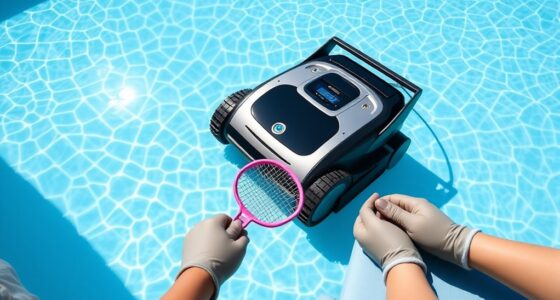To tackle DIY home maintenance projects, you'll want essential tools that ensure efficiency and precision. Start with hand tools like a comfortable hammer, a versatile multi-bit screwdriver set, and an adjustable wrench for plumbing tasks. Don't overlook a quality cordless drill and a reliable tape measure for accuracy. Power tools like a circular saw and impact driver can make your projects easier and faster. Safety gear is crucial too—ensure you have eye protection and sturdy work boots. If you stick around, you'll uncover even more tips and tricks to elevate your DIY game.
Key Takeaways
- Essential hand tools like a hammer, multi-bit screwdriver set, and adjustable wrench are vital for various DIY home maintenance tasks.
- A cordless drill and impact driver enhance efficiency by saving time and providing extra torque for driving screws.
- Measuring and leveling tools, such as a tape measure and bubble level, ensure accuracy in all home projects.
- Safety gear, including eye protection and sturdy work boots, is crucial to protect against potential hazards during DIY activities.
- Organizing tools effectively and investing in quality options lead to improved efficiency and better project outcomes.
Essential Hand Tools
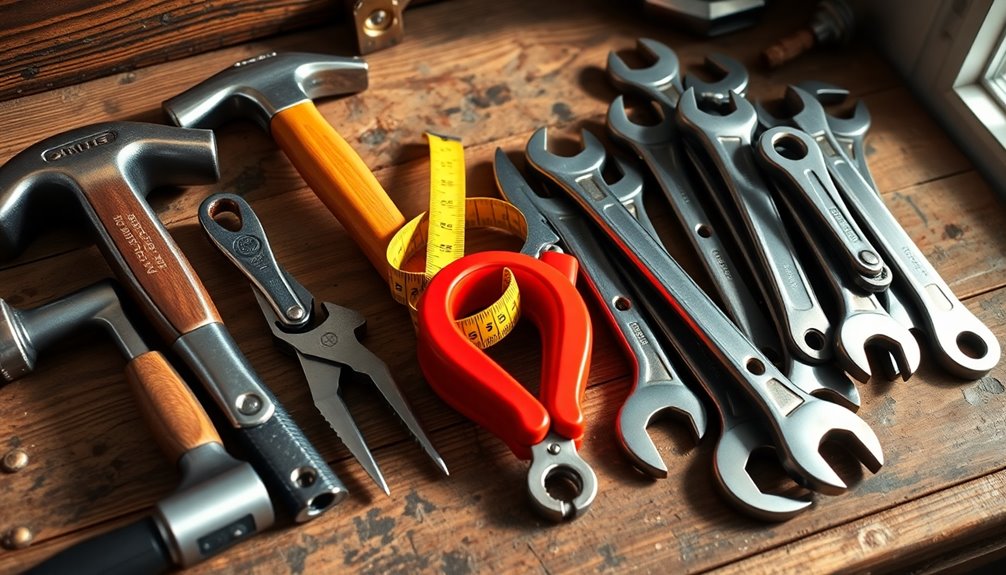
When it comes to DIY home maintenance, having the right hand tools is crucial. Start with a reliable hammer; a 16 oz claw hammer is perfect for driving and pulling nails. Look for one with a comfortable grip, like the budget-friendly TEKTON model. Next, a multi-bit screwdriver set is essential for various projects, from furniture assembly to battery replacements. An adjustable wrench is also a must-have, allowing you to tackle plumbing repairs and tighten bolts easily. Don't forget a tape measure; a 25-foot version with a lock button ensures accurate measurements for any project. A cordless drill is also a versatile tool that can save you time and effort during your DIY tasks. With these essential hand tools, you'll be well-equipped for all your DIY tasks.
Power Tool Must-Haves

Power tools are game-changers for DIY home maintenance, making tasks quicker and easier. A drill/driver is essential for tasks like assembling furniture and hanging pictures, and its adjustable torque and speed settings enhance versatility. The circular saw excels at making precise cuts in various materials, while the jigsaw allows for curved cuts and detailed work. An oscillating multi-tool is indispensable for reaching tight spaces and offers various blade options. For heavy-duty tasks, an angle grinder is a must, and a power sander speeds up your finishing projects. Finally, an impact driver provides the extra torque needed for driving large screws. Investing in high-quality tools ensures reliability and performance, allowing you to tackle any home project like a pro! Moreover, utilizing the best vacuums for dust removal can help maintain a clean workspace while you work on your projects.
Measuring and Leveling Equipment
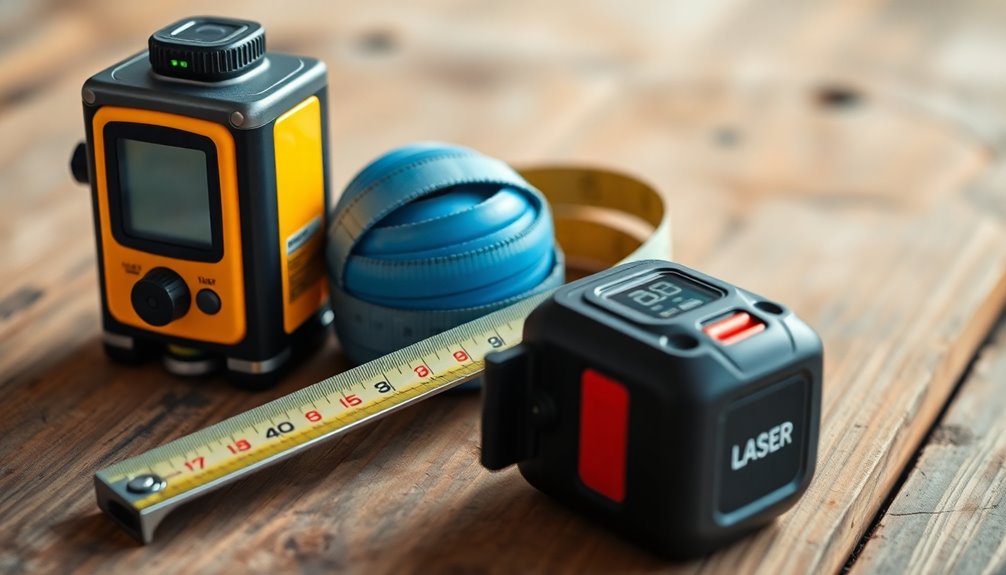
Measuring and leveling equipment is crucial for ensuring accuracy in your DIY projects. A good tape measure is a must-have; opt for the DEWALT Atomic Compact Series for precise fractional markings. Whether you're measuring room dimensions or board lengths, it's versatile and essential. Cost savings can also be achieved by investing in quality measuring tools that will last for years. Additionally, using a reliable budget-friendly maintenance plan can help you keep your tools in optimal condition.
For ensuring objects are level, consider bubble levels for ease of use or digital levels for precise angle measurements. Stabila Box Beam Levels are highly recommended. Also, a stud finder helps locate studs in walls, making it easier to hang heavy objects securely; the Zircon StudSensor A100 is reliable.
Don't overlook additional tools like rafter squares and laser tape measures for more complex tasks. These tools will elevate the quality of your work.
Safety Gear for DIYers
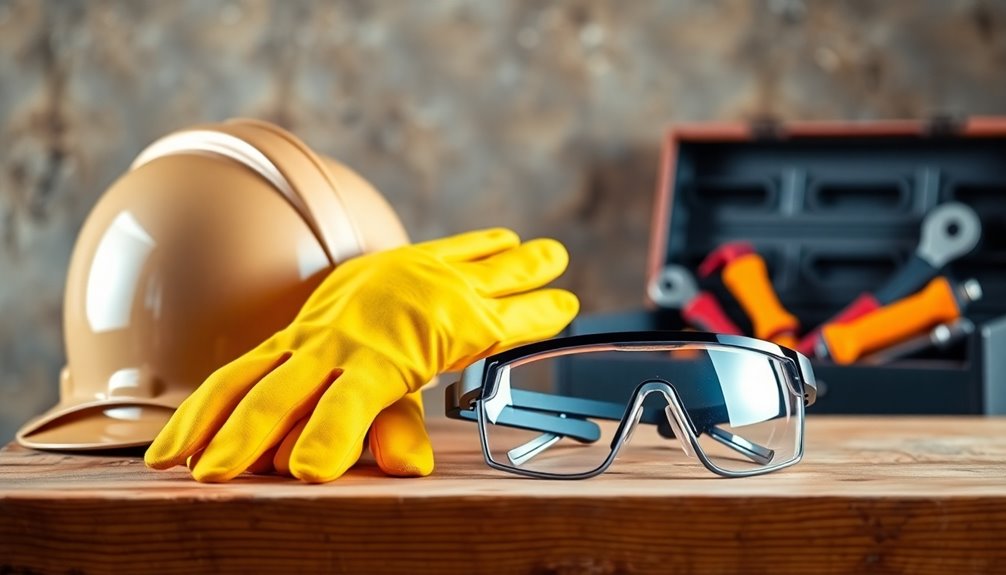
Safety gear is essential for any DIYer, as it helps protect you from potential hazards while working on projects around the home.
Start with eye protection—safety glasses or wraparound models shield your eyes from debris and liquids. For noisy tasks, earmuffs or earplugs with a good Noise Reduction Rating (NRR) are vital. A stocked first aid kit and a fire extinguisher are crucial for emergencies. Regular checks for wear and effectiveness of your hearing protection gear can ensure optimal safety during loud projects.
Wear sturdy work boots, ideally with composite toe protection, and consider using gloves for hand safety. If you're working in dusty or chemical-laden environments, respirators and dust masks are a must.
Lastly, don't forget sunscreen for outdoor projects to protect your skin from harmful UV rays. Always prioritize safety!
Miscellaneous Handy Tools

While tackling various DIY projects, having a selection of miscellaneous handy tools at your disposal can make all the difference.
A utility knife or putty knife is invaluable for carpentry and appliance repairs. Keep a spool of twine handy for marking and measuring items accurately. A staple gun is a versatile tool, perfect for various projects around the house. Additionally, investing in quality tools ensures that your DIY projects yield better results and last longer.
Don't forget your safety glasses to protect your eyes from debris during work. A mini LED flashlight can illuminate dark spaces, enhancing your efficiency.
These tools, combined with proper organization and storage solutions, ensure you're always prepared for whatever DIY task comes your way. Equip yourself with these essentials, and you'll tackle projects with confidence.
Advanced Power Tools

Building on your collection of handy tools, advanced power tools can elevate your DIY projects to a new level of efficiency and precision.
A cordless drill is versatile and portable, making it perfect for drilling holes and driving screws, with adjustable power for various tasks. An electric screwdriver adds comfort and precision, especially for projects involving many screws, while preventing over-tightening. Additionally, using power tools enables you to handle both small and large repair tasks with ease.
Meanwhile, a power sander ensures smooth finishes on wood surfaces, speeding up your sanding tasks compared to manual methods.
Lastly, a circular saw offers precision cutting and superior power for various materials, making it indispensable for larger projects.
Together, these tools enhance your capabilities, making home maintenance easier and more enjoyable.
Tool Maintenance Tips
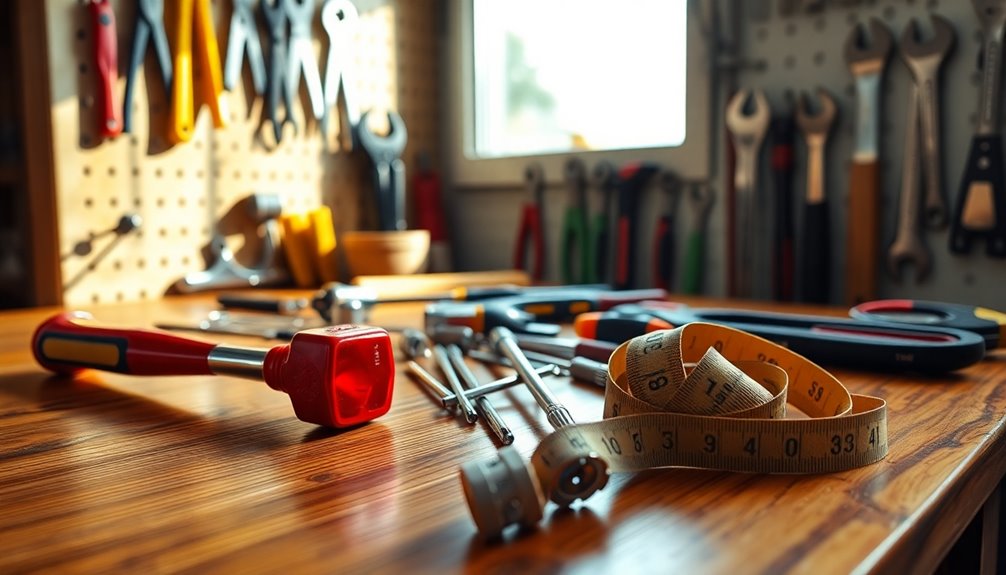
To keep your tools in top shape and extend their lifespan, regular maintenance is essential.
Start by checking for wear and tear; look for dull blades or worn grips. Inspect handles for cracks and monitor performance for any issues.
Clean your tools using mild soap and water, removing rust with a wire brush or sandpaper. Make sure to dry them thoroughly to prevent rusting.
Regularly lubricate moving parts to reduce friction and prevent corrosion, and always follow the manufacturer's instructions. Proper care reflects a commitment to quality work.
Store your tools in a dry place, using protective cases to avoid damage. Handle them with care and avoid harsh chemicals that can cause harm.
Simple steps can significantly enhance the life and performance of your tools.
Organizing Your Tool Space
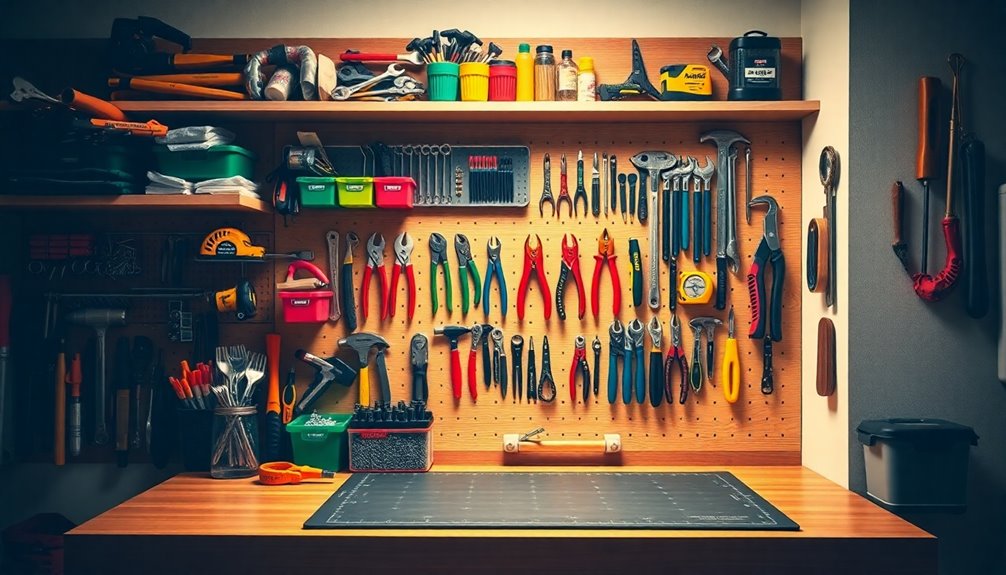
Keeping your tools well-maintained sets the foundation for an organized workspace. Start by creating a PVC pipe tool organizer to utilize vertical space. Cut the pipes to fit your tools, and use wire shelves for added support. Organizing power tools efficiently not only reduces clutter but also facilitates easy access to your tools.
Pegboards are another fantastic option; mount them on your walls and use hooks to keep tools easily accessible. If you prefer a more robust solution, invest in a tool cabinet with sliding drawers for larger items and shallow trays for hand tools.
Lastly, modular tool storage solutions, like stackable boxes on wheels, offer flexibility and mobility for your projects. By organizing your tools effectively, you'll streamline your DIY tasks and keep your workspace clutter-free.
Budget-Friendly Tool Options
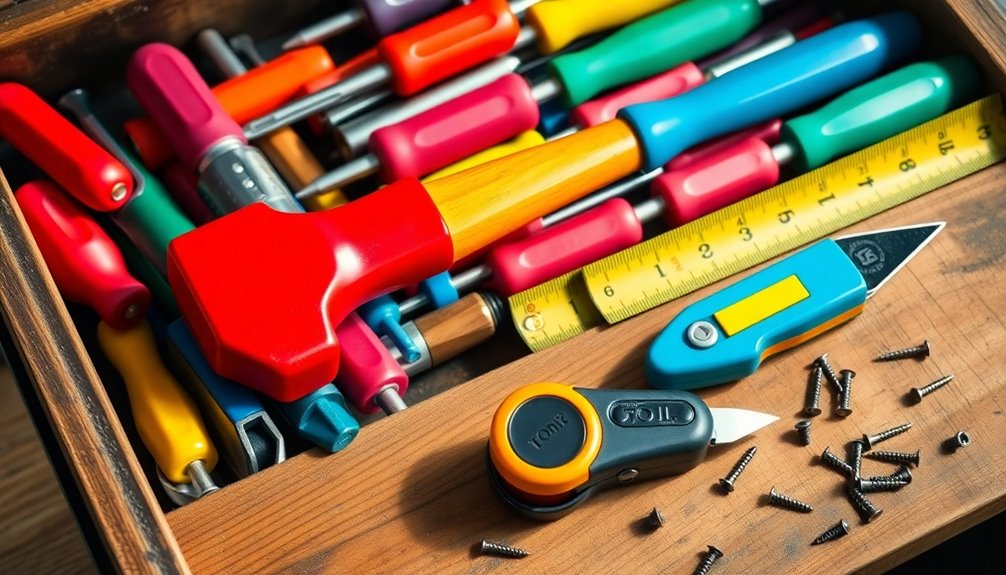
When you're starting your DIY journey, finding budget-friendly tools can make all the difference. Focus on essential items like a TEKTON 16 oz. claw hammer for $10-20, perfect for hanging pictures and basic repairs. A multi-bit screwdriver set ($15-25) with a magnetic holder simplifies furniture assembly and minor tasks. An 8-inch adjustable wrench ($10-15) is great for plumbing and tightening bolts, while a 25-foot tape measure ($5-10) is vital for accurate measurements. Investing in quality measuring tools is crucial for ensuring precision in your projects. Lastly, grab a 3-piece pliers set ($15-25) for gripping and cutting tasks. By investing in these tools, you'll be well-equipped for various projects without breaking the bank. Check local stores, online sales, or estate sales for the best deals!
Frequently Asked Questions
What Are the Best Brands for DIY Tools?
When considering the best brands for DIY tools, you can't go wrong with Hi-Spec for affordability and variety.
Black+Decker offers durability and ease of use, making it a favorite among DIY enthusiasts.
Ryobi's One+ System provides convenience with its extensive battery compatibility.
Lastly, Craftsman stands out with its solid build quality and excellent warranties.
Each brand caters to different needs, ensuring you find the right tools for your projects.
How Do I Choose the Right Tool for My Project?
To choose the right tool for your project, start by identifying the specific task you need to accomplish.
Consider the materials you'll be working with and opt for tools that can handle multiple functions.
Assess the quality and durability of the tools; reputable brands often provide better longevity.
Don't forget about safety features and how you'll organize your tools.
Ultimately, selecting the right tools makes your project smoother and more enjoyable.
Where Can I Find Reliable Tool Reviews?
When it comes to finding reliable tool reviews, you've got to separate the wheat from the chaff.
Start by checking out YouTube channels like Project Farm or Ave/Boltr for in-depth analysis. Websites like Protoolreviews and Toolboxbuzz can also provide valuable insights, though some might lean biased.
Don't forget forums like Reddit's r/DIY, where real users share their experiences. Exploring manufacturer and retailer reviews can give you a well-rounded perspective too.
How Often Should I Replace My Tools?
You should replace your tools based on their wear and usage patterns. If you notice decreased performance or dullness, it's time for a change.
Cutting tools, for instance, wear faster under high production volumes or when used on hard materials. Regular maintenance, like sharpening and cleaning, can extend their life.
Always check the tool quality and adhere to manufacturer guidelines to ensure optimal performance and longevity. Keep an eye on how often you use them!
Can I Borrow Tools From Neighbors or Friends?
Yes, you can borrow tools from neighbors or friends, but it's important to establish clear ground rules first.
Set a specific time period for borrowing and communicate when you'll return the tool. Make sure you both agree on how it should be used and keep track of what you've borrowed.
Discuss any insurance implications, and consider creating a neighborhood tool-sharing group to facilitate borrowing and foster community connections.
Conclusion
In conclusion, having the right tools is essential for tackling DIY home maintenance projects effectively. Did you know that nearly 70% of homeowners say they feel more confident taking on projects when they're well-equipped? By investing in essential hand tools, power tools, and safety gear, you can transform your space and boost your skills. So, gear up, get organized, and unleash your creativity—those home improvements are within your reach!


